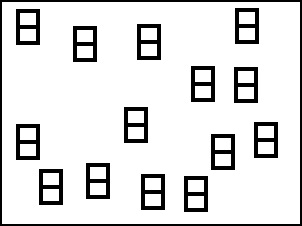Essay 7.3 Attentional Capture
Cues can direct the deployment of attention, but sometimes attention is summoned in a more insistent manner. If someone fires a camera’s flash in your face unexpectedly, your attention will be attracted to the flash even though you were not prepared for that cue. Your attention has been “captured.” The term attentional capture would seem to imply a deployment of attention that is involuntary and mandatory. What sort of stimuli capture attention? Steve Yantis (1993) has argued convincingly for new objects as the most important class of such stimuli.
A typical Yantis experiment is illustrated by the figures below. At the start of a trial, a subject would see a number of “placeholders” shaped like a digital eight. At some point, line segments are removed from the eights to form letters like S, H, E, etc. The subject’s task might be to determine if the letter “F” is in the set.
In the first example (Image 1), all of the letters are created by turning off line segments of the placeholder “8”s. This is called an offset stimulus. In this case, the subject will need to search through the letters in order to find the “F.” The more letters, the longer the search will take, just as in the inefficient visual search experiments discussed in the textbook and in Activity 7.2.

Image 1 Offset target condition of the Yantis paradigm. Click the image to turn the "placeholders" into letters, then see how quickly you can find the "F" in the display. Further clicks of the image will toggle the placeholders and letters back and forth.
The bottom image (Image 2) shows a different situation. Here the “F” is an onset stimulus. It appears out of nothing in the display while all the other letters are offset stimuli, derived from the placeholders. In this situation, the response time does not depend on the number of place holders—the same pattern seen in the “feature search” tasks in the textbook. Here, it seems that attention goes first to the new object, no matter how many old objects are present. Many experiments of this sort make the case that it is the appearance of a new object that grabs attention and not just a low-level sensory stimulus like the onset of a light (Yantis, 1994).

Image 2 Onset target condition of the Yantis paradigm. Click the image to turn the "placeholders" into letters, then see how quickly you can find the "F" in the display. Further clicks of the image will toggle the placeholders and letters back and forth.
Though these experiments provide one of the operational definitions of attentional capture, it is not clear how mandatory attentional capture really is. All else being equal, attention will go to the new object. But if, for example, subjects know that the new object is never going to be the target, they do seem to be able to avoid attending to it (Yantis, 1990). Is there any true attentional capture? The point is extensively argued to this day though the final word may have been offered by James Sully in 1892 when he wrote that “one would like to know the fortunate (or unfortunate) man who could receive a box on the ear and not attend to it.”
References
Yantis, S., and Johnson, D. N. (1990). Mechanisms of attentional priority. J Exp Psychol Gen Human 16: 812–825.
Yantis, S. (1993). Stimulus-driven attentional capture. Curr Dir Psychol Sci 2: 156–161.
Yantis, S., and Hillstrom, A. P. (1994). Stimulus-driven attentional capture: Evidence from equiluminant visual objects. J Exp Psychol Gen Human 20: 95–107.

